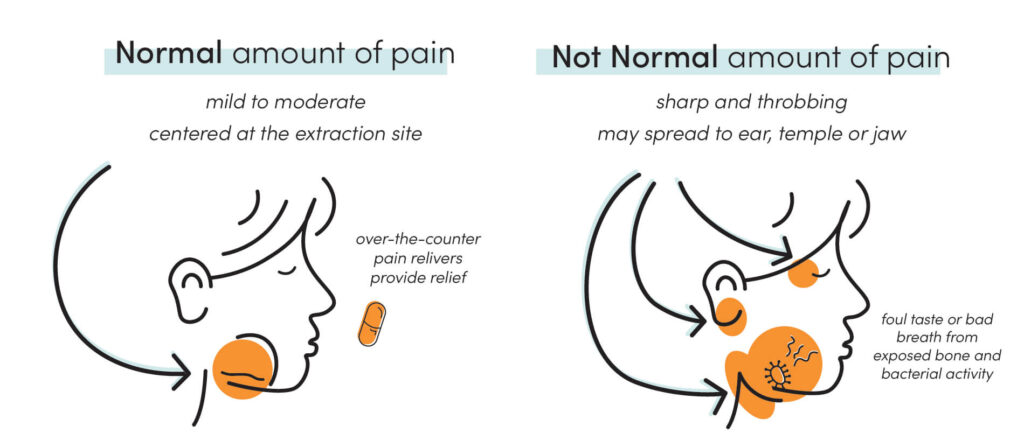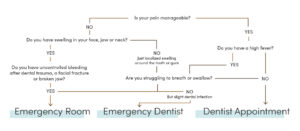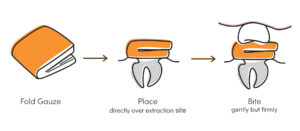How to Know If You Have Dry Socket: Clear Symptoms and Signs Explained

Reviewed By Dr. Dennis Rollins, DDO |
July 2025 • 6 min Read
Reviewed By Dr. Dennis Rollins, DDO | July 2025 • 6 min Read
Discomfort and swelling after a tooth extraction do not necessarily mean you have a dry socket. Below you’ll find the guidance we offer patients when they ask us how to tell the difference between signs of a dry socket and normal post-extraction symptoms.
We’ll start with a quick at-a-glance guide. If your symptoms align with those in the middle column, you can rest assured that your post-extraction recovery is progressing normally.
Interpreting Your Pain After a Tooth Extraction
Some pain is normal right after an extraction. It tends to be mild to moderate and centered at the extraction site. Over-the-counter pain relievers usually provide adequate relief, and the pain should gradually decrease over the first few days.
Pain from a dry socket is markedly more severe. It’s sharp and throbbing, and may spread to the ear, temple, or jaw. What’s more, instead of improving, it often intensifies two-to-four days after the procedure. If this description fits your symptoms, it’s important to contact your dentist promptly. Early treatment can relieve discomfort and get you back on the normal track to healing.
Click here for help finding a dentist near you.
“If you think you have a dry socket, you don’t,” wrote one patient on reddit.com. “Coming from someone who has had a dry socket twice. You will not mistake the pain for anything else but a dry socket.”
They go on to offer reassurance about the effectiveness of treatment, noting that “even if you do get it you’ll be fine in time.”
“I experienced severe pain starting on the fourth day post-extraction,” another patient reported on azoralsurgery.com. “The discomfort was unlike any typical toothache I’ve had before. My dentist applied a medicated dressing, which provided significant relief.”



Looks Can Be Deceiving
After your extraction, you may notice a whitish area at the extraction site. That might be exposed bone, which may indicate a dry socket, especially when other symptoms are present, such as severe pain, bad breath, or delayed healing.
However, the whitish area might also be part of the normal healing process, as new tissue grows over the extraction site.
So seeing white doesn’t necessarily signal a dry socket. On the other hand, it is possible to have a dry socket without seeing bone. The blood clot can look like it’s in place while still allowing space for air and food to enter the socket.
In short, looking at your extraction site can be helpful, but it’s important to pay attention to the other potential symptoms listed above.
Reducing Dry Socket Risk
To help prevent a dry socket after a tooth extraction, follow your dentist’s aftercare instructions closely. During recovery, avoid smoking, alcohol, and drinking through straws. Brush and floss regularly but gently, staying away from the extraction site. Keep that area clean with gentle saltwater rinses after day one, and stick to soft, nutrient-dense foods.

What to Do If You Suspect a Dry Socket
Call your dentist right away and make an appointment. Usually, they will gently clean the area, put a medicated dressing in place, and help relieve pain while the extraction site heals.
While you are waiting for your appointment, there are a few things you can do at home to ease discomfort and protect the area:
- Take over-the-counter pain relievers, unless your dentist has advised otherwise.
- Rinse very gently with warm salt water to keep the area clean.
- Hold a cold compress to the outside of your cheek to help with pain and swelling.
- Continue to avoid smoking, alcohol, and straws, as these can worsen the condition.
- Stick to soft, bland foods such as yogurt, mashed potatoes, or smoothies without seeds or chunks of fruit.
- When lying down, keep your head slightly elevated to ease pain and help reduce blood pressure at the site.
None of these measures will cure a dry socket, but they can manage your symptoms until your appointment with your dentist.
Will a Dry Socket Heal on Its Own?
Yes, a dry socket will usually heal without treatment, but it can take weeks. The pain is often intense and can interfere with eating, sleeping, and daily life. What’s more, leaving a dry socket untreated increases your risk of infection.
Seeing a dentist speeds up healing significantly. Many patients feel better within 24–48 hours of treatment, even though full healing still usually takes about a week.
Emotions and Anxiety After an Extraction
It’s common and normal to feel some uneasiness during recovery. The discomfort and the uncertainty can be unsettling. While watching for signs of a dry socket is important, keep in mind that most extractions heal without problems. And even if a dry socket does develop, it is temporary, treatable, and not dangerous when dealt with promptly.
If you’re nervous about getting a dry socket treated, consider finding a dentist who offers anxiety-friendly options, such as nitrous oxide (laughing gas), oral sedation pills, or even IV sedation.
When in doubt, don’t hesitate to contact your dentist with any questions or concerns. Your peace of mind and ability to rest easy are important for your recovery.
Need Help Caring for a Dry Socket?
About The Author
Quisque ultrices tortor risus, sed aliquet neque volutpat maximus. Etiam et sapien eget enim pharetra pharetra a volutpat est. Nulla id aliquam nulla, eu fermentum urna. Aliquam massa ante, vulputate nec urna eu, fermentum feugiat dolor. Nunc quis purus quam.
Related Information

How Much Is a Dentist Visit Without Insurance? Exact Costs Explained
Below, you’ll find a breakdown of typical out-of-pocket costs for common dental procedures, along with the reasons behind these costs. Keep in mind that these costs can vary significantly based on your location, the dentist’s experience, the materials used, and the complexity of the procedure.

Should You Go to the ER for Tooth Pain? A Quick Guide
Whether you should go to the ER for tooth pain depends on the severity of your pain and what other symptoms you’re experiencing. Read on for help deciding how to find relief.

How to Stop Bleeding After Tooth Extraction: Easy Tips for Immediate Relief
After a tooth extraction, some bleeding at the site is normal and will usually slow down within 2-3 hours. Gentle oozing (think pink saliva) will often continue for the first 24 hours. Below you’ll find tips for helping to stop the bleeding, and how to tell the difference between normal recovery and signs that you should call your dentist.
